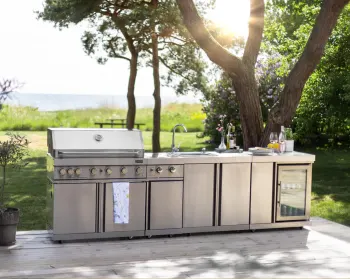As homeowners increasingly embrace outdoor living, the demand for high-quality outdoor kitchen cabinets continues to rise. These cabinets are more than just storage—they form the foundation of a functional and stylish outdoor cooking space. Whether you're building a full-scale backyard kitchen or a compact grilling station, choosing the right outdoor kitchen cabinets is key to enhancing durability, organization, and design.
In this comprehensive guide, we’ll explore the benefits of outdoor kitchen cabinets, popular materials, key features to look for, and how they compare to indoor options. We’ll also touch on design ideas and maintenance tips to ensure your investment lasts for years.

Why Outdoor Kitchen Cabinets Matter
Outdoor kitchen cabinets are essential for keeping cooking utensils, equipment, and food items organized and protected. Unlike indoor cabinets, these are designed to withstand the elements—including rain, snow, UV rays, and temperature fluctuations.
Key Benefits:
Weather Resistance: Made from materials that won’t warp, rust, or rot when exposed to the elements.
Functional Storage: Keeps outdoor kitchens organized and clutter-free.
Enhanced Aesthetics: Complements the overall design of patios and outdoor kitchens.
Increased Property Value: Outdoor kitchens are a top ROI feature in modern homes.
Best Materials for Outdoor Kitchen Cabinets
When selecting outdoor kitchen cabinetry, material choice is critical for longevity and performance. Here are the top options:
1. Stainless Steel Cabinets
Stainless steel is one of the most popular and premium options available.
Pros:
Corrosion- and rust-resistant
Hygienic and easy to clean
Modern, sleek look
Long lifespan
Cons:
Can heat up under direct sun
Higher cost than some alternatives
2. High-Density Polyethylene (HDPE)
HDPE cabinets are made from weather-resistant plastic and are ideal for all climates.
Pros:
Won’t rust, rot, or absorb moisture
Available in a variety of colors and textures
Low maintenance
Cons:
Less heat-resistant than steel
May fade with prolonged UV exposure
3. Teak Wood
For those who love natural aesthetics, teak offers timeless beauty.
Pros:
Naturally water- and pest-resistant
Rich, warm look perfect for outdoor spaces
Cons:
Requires sealing and regular maintenance
Expensive compared to composites or HDPE
Custom vs. Prefabricated Outdoor Kitchen Cabinets
Custom Cabinets:
Designed to fit your exact layout and appliance choices
Allows for high-end materials and tailored aesthetics
Higher initial cost, but long-term satisfaction
Prefabricated Cabinets:
Affordable and faster to install
Limited customization
Suitable for small patios or budget builds
Essential Features to Consider
When planning your outdoor kitchen cabinet installation, consider the following:
Waterproof Seals: To keep contents dry
UV-Resistant Finishes: Prevents fading and cracking
Ventilation Panels: Reduces condensation and mold risk
Soft-Close Drawers and Hinges: Enhances user experience
Insulated Cabinets: Perfect for cold storage or outdoor refrigerators
Outdoor Kitchen Layout Ideas
1. Straight Line Design
Ideal for smaller patios, straight-line layouts align all elements along one wall—grill, sink, cabinets, and storage.
2. L-Shaped Outdoor Kitchen
Maximizes corner space and creates a natural cooking zone with plenty of prep surface and cabinetry.
3. U-Shaped Design
Offers ample counter and cabinet space and is ideal for entertaining larger groups.
4. Island Kitchen
Great for open backyard spaces—combine your grill, sink, and cabinets around a central island to encourage social interaction.
Outdoor Kitchen Cabinet Trends (2025)
Matte Finishes: Clean and modern, resistant to fingerprints.
Dark Tones: Charcoal, navy, and matte black remain popular for an upscale look.
Modular Designs: Flexible cabinets that can be rearranged as needs evolve.
Sustainable Materials: More consumers are opting for eco-friendly and recycled materials.
Maintenance Tips
To keep your outdoor kitchen cabinets looking their best:
Clean regularly with mild soap and water.
Check for rust or mold—especially in stainless steel or wooden models.
Cover when not in use, especially during harsh winters or rainy seasons.
Seal wood cabinets annually if using natural materials like teak.
Inspect hinges and hardware for corrosion or loosening.
Outdoor Kitchen Cabinets vs. Indoor Cabinets
| Feature | Outdoor Kitchen Cabinets | Indoor Kitchen Cabinets |
|---|---|---|
| Material Durability | Designed for all-weather use | Not weatherproof |
| UV Resistance | High | Low |
| Moisture Protection | Excellent | Poor |
| Installation Location | Outdoor patio, backyard | Indoor only |
| Maintenance | Slightly higher | Moderate |
Frequently Asked Questions
1. Are outdoor kitchen cabinets waterproof?
Yes, most outdoor kitchen cabinets—especially those made from stainless steel or HDPE—are designed to be waterproof and weather-resistant.
2. Can I use indoor cabinets outside?
Using indoor cabinets outdoors is not recommended. They are not built to withstand weather conditions and will deteriorate quickly.
3. How long do outdoor kitchen cabinets last?
With proper care, quality outdoor kitchen cabinets can last 15–25 years or more, depending on the material and climate.
Investing in high-quality outdoor kitchen cabinets is a smart decision for any homeowner looking to enhance their outdoor living experience. Whether you prioritize style, functionality, or longevity, there's a perfect material and design waiting for you. From stainless steel to HDPE, modular to custom-built, the right cabinets will elevate your outdoor kitchen and add lasting value to your home.
Whether you're a weekend griller or an outdoor culinary enthusiast, the right cabinetry makes all the difference.

